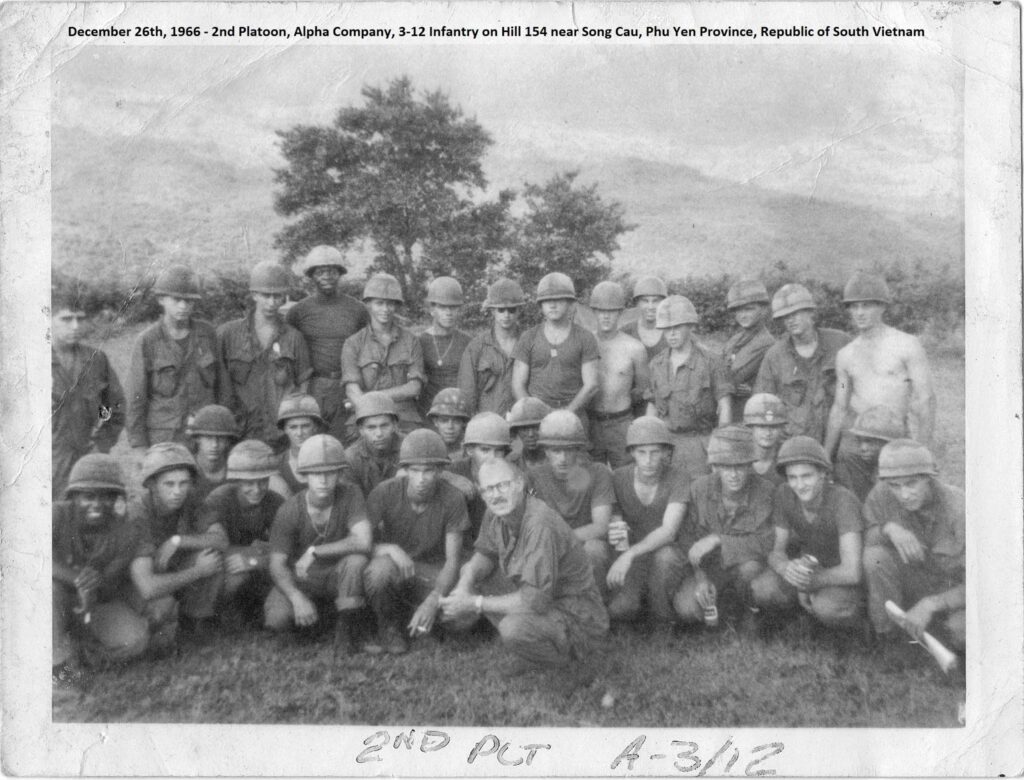The soldiers of the 3-12 Infantry were also encountering an enemy that was the master of the booby trap. Punji stake traps, filled with wooden stakes sharpened and smeared with human excrement were common, and landmines and explosive devices littered the battlefield. But for Bravo Company, 3-12, and one soldier in particular, a peculiar and deadly trap stood out amongst the regular tricks the Viet Cong implemented.
On the night of December 9th, Bravo Company moved through a small village, searching for weapons caches and Viet Cong sympathizers. In the middle of the column, in the inky blackness of the Vietnam night, tragedy struck. SP4 Adrian Ibrom, a married 20 year old mortarman from the small town of Westhoff, Texas was killed when he walked into the open top of the village well. Between the confusion of the dark night and the weight of his gear, there was little chance that he could have been rescued in time. Ibrom, a 1964 graduate of Yorktown High School was the son of Victor and Irene Ibrom.
Throughout Phu Yen Province, the 1st Brigade, 4th Infantry Division continued rice harvest protection missions in support of Operation Adams. In the 3-12, the line companies of Alpha, Bravo and Charlie, experienced combat while in company, platoon and sometimes squad sized actions. Anywhere from 10 to 120 men moving by foot, truck or helicopter from one point to the next. For many of their missions, being seen was the point of it. Show the Viet Cong that the Americans were there, and show the villagers that it was safe to go and harvest their rice. In all of that, the war had become very real, and each company had lost men wounded and killed in action.
In Headquarters Company (HHC), a small group of men existed that was learning how to fight the war in a very different way. The Reconnaissance Platoon consisted of men trained in the art of the long range reconnaissance patrol (LRRP). They were the LRRPs, and instead of groups of 40 to 120, they moved silently through the jungle in groups of six to twelve, and attempted to remain undetected as they surveilled the enemy. On December 11th, the recon platoon had a LRRP in the area northwest of Tuy Hoa. Originally from Louisiana but drafted out of Los Angeles, California in 1965 and trained as a heavy weapons specialist, 21-year old PFC Charles McMasters had a great sense of humor, was easy to get along with and had become a fine soldier. Back home in Louisiana, his wife Helen and mother Josephine waited patiently for his return. As the recon patrol made their way through the jungle, PFC McMasters accidentally triggered a Bouncing Betty booby trap. The explosion sent metal fragments into his head and chest, killing him and mangling the legs of his team leader, Staff Sergeant Earl Jackson.
On December 16th, the Battalion (-), along with elements of the 47th ARVN Regiment, conducted an airmobile assault to locate and destroy enemy forces near Tuy Hoa. This began a series of joint search and destroy operations throughout the greater Tuy Hoa area. Sometimes a company from the 3-12 would act as a blocking force for an ARVN unit, while other times the roles would be swapped, and the Braves would be the ones moving through South Vietnamese villages and hillsides.
As the end of 1966 drew near, the battalion prepared for it’s first Christmas in a war zone and for the next phase of Operation Adams, which would kick off in the new year. In Alpha Company’s 1st Platoon, PFC Edward Chase and PFC Barry Mounce had grown to become good friends. Drafted out of the Detroit, Michigan area together on December 2nd 1965, they had gone through training at Ft. Lewis and the long voyage over on the Gordon by each other’s sides. Both acted as point men on occasion, and often sought each other out when it was time to establish a perimeter.
On December 23rd, Alpha had finished patrolling and was dug in beneath a small mountain near Tuy Hoa. Mounce and Chase selected a spot on the sloping terrain, just under an M-60 machine gun position. Each man had been issued a canvas shelter half, so the two men snapped them together over their foxhole. At one point during the evening, they stood next to each other, looking out over the Vietnam countryside. In an instant, all hell broke loose, and enemy fire began impacting all around them. The men hit the ground immediately, but Barry Mounce, who had saved his wages while working for a pharmacy in 1965 and bought himself dentures in order to have the smile he always wanted, lay bleeding out with a gunshot wound to the neck. He became the sixth and final Brave of the 3-12 Infantry to lose their life in Vietnam in 1966. His buddy Ed Chase, who had stood just inches away but was left unscathed, faced the unpleasant reality of the next 9 months in Vietnam without his best friend.
On December 26th, 2nd Platoon of Alpha Company gathered together on Hill 154, near Song Cau north of Tuy Hoa and had a picture taken. Of the 33 men in the picture, at least six would not survive their tours, and well over half of the remaining men would be wounded at least once. The events of 1966 made it a year they would remember forever. 1967 would become the year none of them could ever forget, no matter how hard they tried.

Sources:
coffeltdatabase.org
https://www.findagrave.com/memorial/170659073/adrian-joseph-ibrom
https://www.vvmf.org/Wall-of-Faces/37110/CHARLES-A-MCMASTERS/
E. Chase, personal communication, August 18, 2020
B. Lomnicki, personal communication, February 5, 2020
